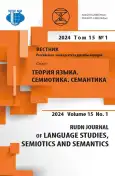Images: Cognitive Mechanism, Poetics, Semiosphere
- Authors: Shestak L.A.1
-
Affiliations:
- Volgograd State Socio-Pedagogical University
- Issue: Vol 15, No 1 (2024)
- Pages: 51-63
- Section: COGNITIVE RESEARCH
- URL: https://journal-vniispk.ru/2313-2299/article/view/323639
- DOI: https://doi.org/10.22363/2313-2299-2024-15-1-51-63
- EDN: https://elibrary.ru/EWFLKE
- ID: 323639
Cite item
Full Text
Abstract
The study is devoted to the phenomenon of the image as a concept of many humanities. The cognitive mechanism for creating a linguistic and textual image (apperception, application of frames with a matching slot, basic categorization of the world) is under consideration. A typology of linguistic images is given: an acoustic image as a second channel of meaning, along with a lexical-and-semantic one; the means of figurative derivation; a figurative internal form of a word of a secondary direct nomination ( осточертеть, накостылять ); lexical figurativeness and syntagmatics of direct and figurative meanings of a monocode (metaphors of one thematic zone) and polycode (metaphors of different thematic areas) kind. It is concluded that the semantic syntagmatics of figurative language means demonstrates the operation of the law of semantic agreement at the level of both explicit and implicit language means. The types of text figurativeness (figurative detail, image-character, correlation of the figurative structure of texts with the concepts of language and style) are considered. The cultural imagery of naming-characteristics of the cultural paradigms of Europe - Antiquity, Middle Ages, Renaissance, Modern times; the evolution of civilizational meanings of previous epochs and their transformation into images of modern language ( египетский труд, высокие амфоры ног, площадная брань, макиавеллизм ) is under the studies. The conclusions are made about the function of an image as a systematizer, an ontology parameter. At the same time, metaphor is a magic crystal of focusing space, time and thought, a linguistic way of connecting simultaneity and continuity of the developmtnt of culture. The scientific novelty of the study lies in the identification of the mechanism of semantic syntagmatics of direct and figurative meanings of lexemes (iteration of denotative, connotative and potential semes; semantic consistency - compatibility of thematic zones “anthropomorphic metaphor - artifact metaphor, anthropomorphic metaphor - naturalmorphic metaphor, phytomorphic metaphor - zoomorphic metaphor”, etc.), as well as in establishing the semiotic evolution of the civilizational meanings of cultural paradigms - the historical transformation, due to the loss of denotations and referents, of the names of denotations into the characteristics of a wide range of objects: патрицианский профиль А.Ахматовой (M. Tsvetaeva) as ‘Roman’, ‘with a proud landing of the head’; марионетка ‘non-independent subject’, ‘state under external control’, барочный торт (L. Ulitskaya) ‘overly decorated’. The article proposes an algorithm for the analysis of a polymetaphorical poetic text.
About the authors
Larisa A. Shestak
Volgograd State Socio-Pedagogical University
Author for correspondence.
Email: l_shestak@mail.ru
ORCID iD: 0000-0002-1961-8914
SPIN-code: 9232-5333
ResearcherId: ABC-6846-2021
Dr.Sc. in Philology, Full Professor, Professor of the Department of Russian Language and Methods of Teaching it, Institute of Russian Language and Literature
27, V.I. Lenin Ave., Volgograd, Russian Federation, 400005References
- Langacker, R.U. (1992). Cognitive Grammar. Moscow: INION. (In Russ.).
- Karasik, V.I. & Milovanova, M.S. (2021). BRIDGE as a Linguistic and Cultural Symbol. RUDN Journal of Language Studies, Semiotics and Semantics, 12(1), 121–136. https://doi.org/10.22363/2313-2299-2021-12-1-121-136 (In Russ.).
- Rosh, E. (1976). Basic Objets in Natural Categories. Cognitive psychology, 7, 573–605.
- Methods of Nomination in the Modern Russian Language (1982). Moscow: Nauka. (In Russ.).
- Temirgazina, Z.K. (2022). A Poeteme as a Tool for the Analysis of a Lyrical Text in L.A. Novikov’s Concept of Language as Art. RUDN Journal of Language Studies, Semiotics and Semantics, 13(2), 249–261. https://doi.org/10.22363/2313-2299-2022-13-2-249-261 (In Russ.).
- Lapshina, M.N. (1996). Semantic Derivation in the Cognitive Aspect (Based on the Material of the English Language) [dissertation]. St. Petersburg. (In Russ.).
- Telia, V.N. (1996). Russian Phraseology. Semantic, Pragmatic and Linguoculturological Aspects. Moscow: yazyki russkoy kul’tury. (In Russ.).
- Apresyan, yu.D. (1974). Lexical Semantics. Synonymous Means of Language. Moscow: yazyki russkoy kul’tury. (In Russ.).
- Shestak, L.A. (2003). Russian Linguistic Personality: Thesaurus Figurative Verbalization Codes: Monograph. Volgograd: Peremena. (In Russ.).
- Lukin, V.A. (1999). Literary Text: Fundamentals of Linguistic Theory and Elements of Analysis. Moscow: Axis-89. (In Russ.).
- Stepanov, yu.S. (2004). Essays on Chaotic Evolution. Moscow: Languages of Slavic culture. (In Russ.).
- Van, N. & Kobylko, ya. (2020). Text Semantic Field Method as a Possibility of Systemic Approach to the Study of Literary Text: on the Material of the Novel “Home of the Gentry” by I.S. Turgenev. RUDN Journal of Language Studies, Semiotics and Semantics, 11(3), 560– 571. https://doi.org/10.22363/2313-2299-2020-11-3-560-571 (In Russ.).
- Essays on the History of World Culture (1997). T.F. Kuznetsova (Ed.). Moscow: yazyki russkoy kul’tury. (In Russ.).
- Rudnev, V.P. (1999). Dictionary of Culture of the Twentieth Century. Key concepts and texts. Moscow: Agraf. (In Russ.).
- Spengler, O. (1998). Decline of Europe: Essays on the morphology of world history. Vol. 1. Gestalt and reality: Per. with him. Moscow: Mysl’. (In Russ.).
- Gumilyov, L.N. (1989). Ethnogenesis and biosphere of the Earth, V.S. Zhekulina (Ed). Leningrad: Leningrad University Publ. (In Russ.).
- Birikh, A.K., Mokienko, V.M. & Stepanova, L.I. (2007). Russian phraseology. Historical and etymological dictionary. Moscow: Astrel: AST: Khranitel. (In Russ.).
- Novikov, L.A. (2007). Artistic Text and its Analysis. Moscow: LKI Publ. (In Russ.).
- Knyazeva, E.N. & Kurdyumov, S.P. (1994). Laws of evolution and self-development of complex systems. Moscow: Nauka. (In Russ.).
- Lotman, yu.I. (2000). Semiosphere. St. Petersburg: Art — St. Petersburg. (In Russ.).
Supplementary files









